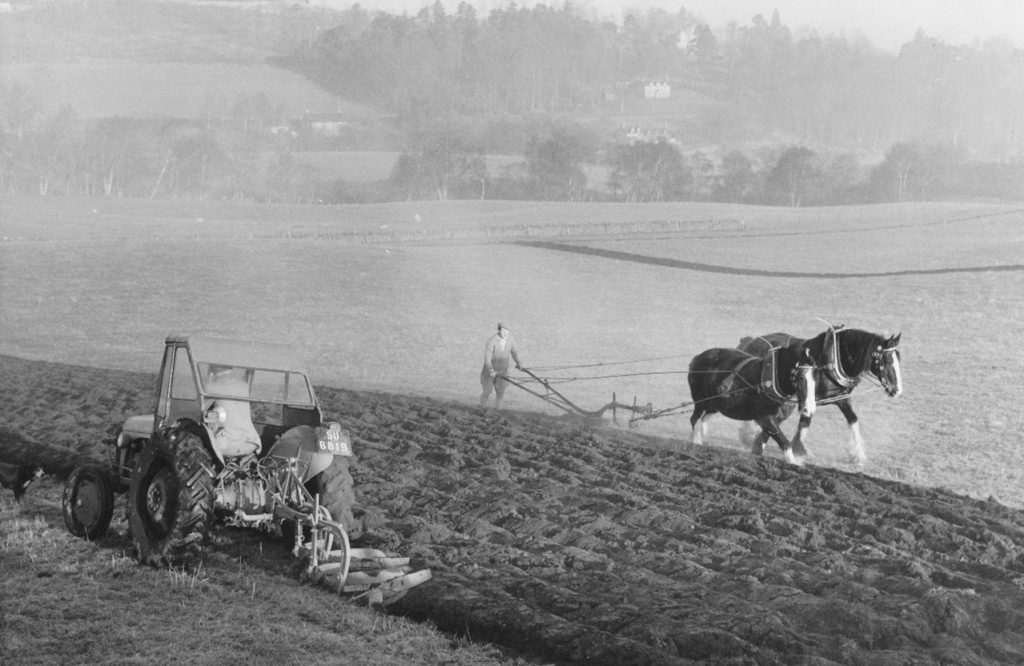At heart, I always have and always will be an agricultural horseman. Yet, about 1965 I first learned to drive on a Ferguson “Little Grey Fergie” TE20 tractor, in effect, possibly the greatest enemy of the agricultural horse in the United Kingdom.

From there, I moved on to such as Massey Ferguson 65, 135, 165 models, and Fordson “Major”, “Super Major”, 4000 and 5000 models. In 1979, working as a professional archaeologist, I even ploughed the topsoil of an archaeological site so that it would be scanned with metal detectors.

The latter was an interesting experience as the borrowed ‘Belarus’ tractor continually spitting out oil, left a lot to be desired and the ’Bamford’ plough only had three of its four intended mouldboards.

It cannot be denied that the introduction of the tractor in the United Kingdom from the First World War ultimately would have a devastating effect on the numbers, use and keeping of agricultural horses. However, in some respects, it might be said that the introduction from 1946 of the Ferguson TE20, the “Little Grey Fergie”, had the greatest effect of all.

Firstly, writing from here in Scotland, it is interesting to reflect upon the numbers of agricultural horses used in Scotland, where there were many small farms. Despite a small increase in horses during the First World War, partly owing to breeding for horses required for military use, as may be expected the numbers significantly drop by 1930 and continue to do so.

Again, during the Second World War, the numbers rise, partly owing to such as fuel rationing. Notably, however, it may be seen that between 1945 and 1949, the number of agricultural horses in Scotland drops by 51,333. Allowing for the number of Fordson, International and other makes of tractor, it cannot be more than a coincidence that this drop matches the introduction of the Ferguson TE20 from 1946. By the end of its production in 1956, 517,651 of the Fergusons had been built, emphasising its inevitable effect on horses.

Promoting the use of their Ferguson TE20 in Scotland, in circa 1950 the company produced a compelling booklet titled ‘Freed from Bondage, Mechanisation opens a new era for small farmers’, implying that the culture associated with agricultural horses was tantamount to unnecessary slavery. It made cogent arguments too regarding the associated finances:
“With a potential profit of £17 per acre, how can a 26-acre farmer afford to use a third of his acreage to keep a pair of horses – the minimum requirement for ploughing? According to Scottish figures 1.4 tons of oats and 1.9 tons of hay are needed to keep a horse, which means 2½ acres for oats and nearly three acres for hay for a pair of horses, not to mention 2½ acres for grazing. The smaller the farm the greater the proportion of land is wasted in feeding horses.”
“Cost of keeping horses ……… In the figures given earlier tractors have been costed at 2s. 10d. an hour, including depreciation. Actually on the 20-acre farm the tractor would work only about 300 hours at a total cost of £42 10s compared with the loss of 8 acres of land if horses were used – land which might have earned £136.”

In addition to the everyday economics, the Ferguson TE20 was relatively cheap to buy. The image illustrates one on show at the ‘Three Counties Show’, Hereford, England in 1947. As shown, it was £372 to purchase.

In conclusion, despite my undying passion for the agricultural horse, I still have a “soft spot” for the grey “Fergie”, the little tractor with great heart that contributed to and achieved so many things for both the small and big farmer.
Author: Bob Powell, Kingussie, Scotland, July 2023.
